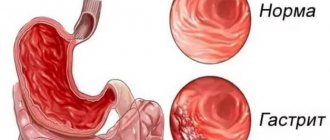- December 11, 2019
- Gastroenterology
- Konstantin Kim
An ulcer or gastric ulcer (GUD) is a chronic pathology of the stomach in which the mucous membrane is damaged with the development of a local ulcerative defect in it. The course is recurrent, with exacerbations and remissions. The peak of exacerbations is often seasonal – spring-autumn. The pathology is caused by trophic disorders under the influence of aggressive factors when their effect prevails over protection.
The frequency of pathology is 10-15% of the population. The disease is most common between the ages of 25 and 50, and less common in women. This is the most active period of life, when frequent stress, dry food, alcoholism, all kinds of extreme diets, etc. occur.
According to statistics, ulcers occur in 70% of patients between 25 and 50 years of age, and in every fifth person after 50 years of age. An ulcer does not occur suddenly; it is preceded by diseases of the stomach and intestines.
Morphology of the ulcer
The gastric mucosa is very durable, it can withstand the action of hydrochloric acid, the causticity of pancreatic enzymes, and hunger strike. Gastric juice kills 99% of pathogens, so a healthy person, even when eating stale food, most often has no consequences.
When a healthy person skips a meal, he or she may experience unpleasant sucking sensations in the epigastrium, but no more. Then he can take food again, and this will not affect his health. It's a completely different matter with an ulcer.
Here the mucous membrane is thinned, and pockets of inflammation may occur in it. These are gastritis, and neglecting the timeliness of meals is already painful. The mucous membrane is easily corroded by gastric juice, acidity increases. Eating any food at any time is no longer an option.
First, erosions form - more superficial damage to the mucosa. When moving into deeper layers (submucosal and muscular), ulcers appear. A healed ulcer is a scar.
Therapy
The effectiveness of treatment will be effective not only due to the use of modern medications and other manipulations, but also from nutrition. Treatment of gastritis begins with a gentle diet and changes in the rhythm of life in general. Therapeutic nutrition for gastrointestinal diseases is an important element of recovery. When a patient’s pathology causes weight loss, they should eat every 2 hours and in small portions. The diet for gastritis and ulcers is based on the fact that the following dishes included in the following list must be removed from the diet:
- fried foods, spicy and fatty foods;
- bread, other than bran;
- baked goods;
- seasonings and sauces for dishes;
- fresh milk.
What can you eat if you have gastritis, what dishes are recommended, what is on the permitted list? Fermented milk products - cottage cheese and low-fat kefir are very valuable dishes, it is recommended to immediately switch to them.
The drug treatment method is based on taking the following medications for gastritis and stomach ulcers:
- Almagel;
- Ranitidine;
- Platyfillin;
- Atropine;
- Omeprazole;
- Famotidine;
- Rabeprazole.
Pills for gastritis - enzymes - also help when the first signs of gastritis are already present:
- Pancreatin;
- Mezim-forte;
- Panzinorma;
- Festala;
- Digestala.
It is often necessary to take antibiotics for gastritis:
- Clarithromycin;
- Amoxicillin;
- Tindazole.
Mechanism of ulcer development
There is always mucus on the surface of the mucosa. It is produced by special cells of the stomach, its role is protective. Under stress, predominant vagal tone, or under the influence of hormonal disorders, mucus is produced in a smaller volume, and some area of the mucous membrane appears to be particularly weakened. The further mechanism is as follows: inflammation of the epithelium appears, which is expressed in some discomfort in the stomach area. If measures are not taken, the inflammation process goes deeper, the painful sensations intensify and are replaced by degenerative changes in the mucosa. Next comes erosion, the mucous membrane in some areas is deeply destroyed. This is where an ulcer forms, this is the mechanism of the so-called stress ulcer. With the integrity of the stomach wall, its functionality is also impaired.
When H. Pylori penetrates the stomach wall, the bacterium uses its flagella. They attach it and remain in place for a number of years. It has the property of producing the enzyme urease, which breaks down urea into ammonia. And it already neutralizes hydrochloric acid, alkalization of the stomach environment occurs.
Nothing prevents bacteria from developing and multiplying, forming an infectious focus. Epithelial cells begin to die, the mucous membrane is destroyed and an ulcer appears.
Etiology of the disease
There are many reasons given, as well as theories, but none of them is a direct provocateur. The main factors for the appearance of ulcers are dietary errors, accompanying pathologies of the gastrointestinal tract and an unhealthy lifestyle. Particularly harmful are repeated stress, irregular food intake, smoking and alcohol. All this leads to the fact that gastric juice has a destructive effect on the gastric mucosa.
In recent years, the bacterium Helicobacter pylori has been called the culprit of the ulcer. When it multiplies, it alkalizes the stomach, food digestion worsens, and gastritis with low acidity occurs. Currently, the presence of bacteria has been detected in almost all people, but they live in an acidic environment and do not cause harm to everyone.
Helicobacter pylori is a factor in the development of ulcers only in 40% of cases. Otherwise, the culprits are:
- abuse of spicy foods, poor diet, caffeine-containing and energy drinks;
- anomalies of the autonomic system;
- stress;
- infections that reduce immunity - HIV and tuberculosis;
- smoking and alcohol;
- uncontrolled use of anti-inflammatory drugs.
The provocateurs are:
- bad heredity;
- peritoneal injuries;
- anemia and hypovitaminosis;
- disorders in the lungs, heart and kidneys.
Treatment of stomach ailments
Stomach diseases should be treated according to symptoms based on comprehensive diagnostics. The general treatment method for all gastrointestinal ailments is fasting and diet. In case of exacerbation of diseases, fasting is recommended for 1-2 days; starting from the 3rd day, a gentle diet is prescribed - first food in a liquid or semi-liquid state (lenten soups, puree soups, jelly). Gradually, dairy and fermented milk products, boiled or steamed lean meat and fish, pasta, weak tea and dried fruit compotes are added to the diet. Avoid the consumption of fatty, fried, spicy and hot foods, preservatives and marinades, mushrooms, flour products and baked goods, vegetables and fruits high in fiber, alcohol and carbonated drinks. The basic principle is separate meals in small portions 5-6 times a day, food should be warm and not irritate the epigastric walls.
Drug treatment
First of all, you need to treat the cause of the malaise. The gastroenterologist decides what medications to take.
If the cause of gastritis is Helicobacter bacteria, a course of penicillin antibiotics and tetracycline is prescribed. To protect the gastric mucosa from corrosion by hydrochloric acid, antacids (Maalox, Rennie, Almagel, Gastal, Bismuth) are prescribed.
In case of low acidity, the patient is administered drugs containing hydrochloric acid or derivatives of gastric juice (Acidin-Pepsin, Betacid). To relieve congestion in the gastrointestinal tract, drugs are prescribed that stimulate peristalsis and speed up the process of food digestion - Mezim, Creon, Pancreatin, etc. In the presence of severe pain, painkillers are prescribed.
Also, in combination, as prescribed by the attending physician, medications are used that accelerate the regeneration of damaged stomach cells. Vitamin complexes, preparations containing nicotinic acid, and immunomodulators improve immunity.
For ulcers, a complex of 3-4 different drugs is often prescribed - Cimetidine, Nisotidine, Livirshpon, Flacarbine, antacids and vitamins (E and group B in various combinations). After the acute relapse has resolved, physiotherapeutic procedures may be prescribed.
Important information: What alcohol can you drink if you have gastritis?
Classification of stomach ulcers
So, the ulcer can be:
- with bleeding;
- with perforation;
- combined;
- without bleeding or perforation.
Systematization of YaBZh:
- in size: small – up to 5 mm; average – up to 1 cm; large – up to 3 cm; giant – more than 3 cm;
- by quantity - single and multiple ulcers;
- by stages of scarring;
- with latent, moderate and severe course;
- according to the level of acidity – hyperacid and hypoacid processes, zero acidity;
Depending on the location of a stomach ulcer, it can be:
- cardiac department;
- body of the stomach;
- antrum;
- pyloric;
- combined ulcers (simultaneously in the stomach and duodenum).
Symptoms
Symptoms of stomach ulcers in adults at the initial stage do not differ from gastritis:
- Spasmodic drawing gastralgia in the center at the angle of the sternum.
- Sour belching.
- Heartburn.
- Intermittent nausea after eating.
- Decreased appetite and weight loss.
How to understand that a stomach ulcer has occurred:
- Nausea and pain become constant.
- Sour belching with bitterness.
- Heartburn.
- Vomit.
- Constipation.
- Decreased appetite.
What kind of pain occurs with a stomach ulcer? During an attack, the pain is unbearable and manifests itself in the form of contractions and spasms. Accompanied by tachycardia, pallor of the skin. After eating, heaviness and a feeling of fullness in the stomach often appear.
The nature of pain with a stomach ulcer can be supplemented by a fairly common symptom - this is pain at night. After eating or taking antacids it decreases and disappears. A white coating appears on the tongue, a heavy metallic odor from the mouth, and the skin changes. There is an aversion to food or a decrease in appetite, night hunger pains arise, which must be eaten, sweating increases and a tendency to constipation.
Other symptoms of stomach ulcers in adults: a person’s hair becomes dry and brittle, the complexion turns pale, the lips are dry, with puffiness in the corners of the mouth. The ulcer sufferer is constantly tired, anxious and irritable.
Where does it hurt with a stomach ulcer? Localized just below the ribs, the pain often radiates under the shoulder blades, into the sternum. Therefore, it can be confused with a heart attack. The danger of an ulcer lies in its silence: it can occur without symptoms, but the processes of destruction in the wall of the stomach continue. There is a risk of gastric bleeding and peritonitis. People with low acidity are at risk for developing cancer, while high acidity more often provokes perforation of an ulcer.
How does a stomach ulcer hurt? Pain is almost always present, even unexpressed. Already at the initial stage after eating, discomfort occurs. At first, this is felt only with harmful foods - pickles, smoked foods, fats, and then the sensation occurs with any food.
How does a stomach ulcer hurt? In ¾ of all patients, pain is localized in the center of the epigastrium. It is seasonal. In half of the patients the picture is blurred, but the pain always intensifies with physical effort, consumption of prohibited foods, and smoking.
Where does the pain from a stomach ulcer go? It tends to radiate to the heart area, back, and navel, which makes diagnosis difficult. There may also be other manifestations: flatulence, increased appetite, but quick satiety, decreased mood and poor sleep, hyperhidrosis of the palms.
Abdominal pain with a stomach ulcer usually gradually subsides after eating. They manifest themselves differently depending on the location of the ulcer. For example, an ulcer in the cardiac region has the following symptoms: pain occurs after eating 20 minutes, it is not sharp, it is located closer to the heart, in the upper abdomen. Accompanied by vomiting and nausea.
How does a stomach ulcer manifest itself (symptoms) with an ulcer in the lesser curvature? Here the ulcer is prone to perforation. A dangerous complication is peritonitis. The localization of pain is along the midline of the abdomen to the left. Occurs after eating at different times. Intensifies with a long break in use. Characterized by aching pain at night.
How does a stomach ulcer (symptoms) manifest on the greater curvature? This type is more often diagnosed in men over 30 years of age. More than 50% of such ulcers become malignant. The pain is mild and often goes unrecognized.
Characterized by the following features:
- the abdominal area ache slightly;
- nausea, maybe vomiting;
- no appetite, a whitish coating on the tongue;
- constipation.
How does a stomach ulcer (symptoms) manifest in the antrum? This type is diagnosed in 15% of cases, more often in young people. Gives complications in the form of bleeding and cancer. The symptoms are reminiscent of a duodenal ulcer: stomach pain when hungry, pain worse at night, persistent heartburn and vomiting, a feeling of fullness in the stomach and blood in the stool.
How does a stomach ulcer (symptoms) manifest in the pyloric part? Helicobacter pylori likes to settle here more often than other departments, which is why it got its name. The most characteristic signs:
- prolonged (more than half an hour) night pain;
- a lot of saliva in the mouth;
- the stomach is bloated after eating;
- heartburn and belching;
- sometimes vomiting sour;
- nausea.
Possible complications
Complications include the following:
- The most common occurrence is perforation of the ulcer followed by bleeding or peritonitis.
- Pyloric stenosis with the development of even obstruction.
- Malignization - the transition of an ulcer to a tumor - is observed in 2-12% of cases; The causes of degeneration have not been fully explored.
- Gastric perforation can occur suddenly and has a reactive development.
- Stomach bleeding in the form of small blood losses becomes the norm for the pathology. This is usually due to a damaged artery. Profuse bleeding occurs when an ulcer is perforated. Vomiting of “coffee grounds” is characteristic, the skin is pale, cold sweat appears, the pulse increases and decreases, the pressure drops, the stool turns black (melena). An urgent ambulance call and hospitalization are required.
- Penetration - occurs when the stomach wall is destroyed, when the ulcer moves to the surface of a neighboring organ. Most often this is the pancreas.
- Acute destructive pancreatitis - develops when gastric juice enters the pancreas.
Symptoms of a perforated ulcer (perforation)
A perforated stomach ulcer is the most dangerous complication that happens. Perforation takes 4th place after diseases such as inflammation of the appendix, acute intestinal obstruction, strangulated hernia.
Perforation complicates the course of peptic ulcer and duodenal ulcer.
If you look at the statistics, 6-20 percent of patients with peptic ulcers are found in 5-10 percent of young people; in patients with perforated ulcers, about 90 percent are men, and in people from twenty to eighty years of age, more than 80% are those who are over 60 years old. – 4.2 percent.
Symptoms of a perforated ulcer are expressed by bleeding, which greatly complicates the course of the disease, regardless of its duration. Occasionally it is the very first manifestation of the so-called “mute”, i.e. asymptomatic ulcers. With heavy bleeding, vomiting with an admixture of dark-colored blood or “coffee grounds”, pale skin, dizziness, and even fainting of varying durations appear. Over the next few days, low blood pressure and loose black stools are usually noticed.
Hemoglobin can remain within generally accepted standards. Massive bleeding can only be stopped in a hospital setting. It is not uncommon for severe bleeding to occur that death begins after a few minutes. Mild gastric bleeding can stop on its own, the state of health is not affected, the only sign of it is the color of the stool black.
Factors contributing to perforation:
- alcohol consumption;
- plentiful food;
- physical stress;
- nervous tension (stress);
- after probing
- complicated ulcer combined with blood thinning medications, vascular thrombosis
- First aid for ulcers! You can drink a little milk with a pinch of soda until the ambulance arrives.
Medications
Medicines prescribed:
- Groups of antibiotics used for Helicobacter pylori infection: macrolides (“Erythromycin”, “Clarithromycin”); penicillins: Amoxicillin"; nitroimidazoles: Metronidazole and its analogues. To destroy Helicobacter, 1-2 courses of antibiotics are prescribed.
- Antacids reduce the acidity of gastric juice and protect the walls of the stomach - Maalox, Rennie, Almagel, activated carbon and Polysorb.
- Antisecretory agents include: H-2 histamine receptor antagonists. They block the receptors of cells that produce hydrochloric acid - Ranitidine, Nizatidine, Famotidine.
- Proton pump inhibitors (PPIs) are the main drugs used in the treatment of ulcers. They block the final stage of the formation of hydrochloric acid: “Omez”, “Omeprazole”, “Rabeprazole”, “Rabelok”, “Lansoprazole”, “Pariet”, “Nexium”.
- Pain relief from stomach ulcers, which is not blocked by antispasmodics and antacids, is produced by M-cholinergic receptor blockers. There is only 1 drug and its analogues - “Pirenzipine” (“Piregexal”, “Gastrotsepin”, “Gastromen”).
- Protection of the mucous membrane - gastroprotectors: “Venter, De-Nol”, “Solcoseryl”, “Misoprostol”.
- To normalize acidity and increase mucus production, Cytotec and Misoprostol are used.
- Preparations for the repair of the mucous membrane – “Sucralfate”; “Biogastron”, “Kaved-S”, “Entrostil” also accelerate the restoration of the gastric mucosa.
- Bismuth preparations have an antiseptic, enveloping and astringent effect, for example, Vikalin.
- Ganglion blockers are aimed at blocking the passage of impulses from the sympathetic nervous system. This promotes the healing of ulcers and ultimately reduces pain - “Quateron”, “Benzohexonium”, “Dimecoline”.
How to relieve pain with a stomach ulcer? Just the above-mentioned drugs.
Treatment of the stomach using traditional methods
Simultaneously with drug therapy, treatment with folk remedies is carried out. There are many different recipes that help eliminate unpleasant symptoms.
- Taking sunflower, olive or sea buckthorn oil on an empty stomach. The dosage is 2 tablespoons.
- Preparation of a medicinal drink from water and honey. Take two tablespoons of honey per mug of boiled water. Take one hour before meals in small sips.
- Preparation of medicine from walnuts, honey and butter. You need to consume the finished product one spoon three times a day.
If treatment does not help, you need to visit the doctor again. These two diseases are considered dangerous and pose a threat to the patient’s life. Treatment should be prescribed only by an experienced doctor after examination and examination results.
Operation
Surgical intervention is indicated in the following cases:
- ulcer perforation, bleeding;
- cicatricial narrowing of the pylorus;
- there has been no effect from conservative treatment for more than six months;
- frequent exacerbations – up to 4 times a year;
- ulcers suspicious for malignancy.
The operation is performed using a classic incision or laparoscopy.
Excision of the ulcer is performed - resection, intersection of the vagus nerve (to reduce the secretion of hydrochloric acid and create conditions for scarring of the ulcer).
In addition, physical therapy, herbs, and diet help. Treatment of concomitant stomach diseases is mandatory.
Physiotherapy is applicable outside of exacerbations: electrophoresis, ultrasound, UHF. Spa treatment is useful.
What folk remedies can be used
Traditional medicine offers many remedies that help eliminate symptoms and establish regenerative processes in the mucous membrane, and also regulate the synthesis of gastric juice. Their use can be combined with taking medications, but only after prior consultation with a gastroenterologist.
Recipes for using folk remedies are very diverse. Therapy can be carried out using decoctions and infusions, or with some plants without pre-treatment. It is necessary to select herbs for gastritis based on the existing symptoms and disorders:
| Problem to be fixed | Name of medicinal plants | Method of preparation and use |
| Heartburn | Potatoes, cabbage, ginger | Grind the potatoes, squeeze out the juice and drink half a glass of it before meals. Cabbage juice, as well as a slice of ginger when chewed slowly, have a similar antacid effect. |
| Nausea and vomiting | Peppermint, lemon balm, trifoliate | Herbs must be consumed separately in the form of decoctions. They need to be prepared from a tablespoon of raw materials and a glass of boiling water. It is recommended to drink a decoction of peppermint three times a day, one tablespoon at a time, and the potion from vachta and lemon balm - 50-100 ml per dose 2 or 3 times a day. |
| Stomach ache | Chamomile, gooseberry (fruit) and blueberry, yarrow | Tea is prepared from chamomile (a teaspoon of herb in a glass of boiling water), which is drunk 30 minutes before meals. A decoction is prepared from a tablespoon of gooseberry fruits and a glass of boiling water, which is drunk hot, 200 ml three times a day. The same recipes are used to make tea from yarrow herb and blueberries. |
| Gas formation and flatulence | Fruits of dill and cumin | The recipes for preparing these herbal remedies are very simple: a tablespoon of seeds is boiled for 10 minutes in a glass of water, and then the entire volume of the prepared drug is drunk during the day, 50 ml each (about 4 doses in total). |
| Poor digestion | Fresh basil, nettle, plantain | In case of slow peristalsis and poor digestion, it is recommended to periodically slowly chew a basil leaf. For nettle and plantain, there are recipes for preparing decoctions: you need to take a tablespoon of plant material and pour a glass of boiling water, heat for 5 minutes over low heat, and then cool. You need to drink half a glass of decoctions 3-4 times a day. |
| Diarrhea | Knotweed, blackberry leaves, elecampane | There are various recipes for preparing remedies for diarrhea, but the most effective is considered to be a collection of all these plants, mixed in equal proportions and infused in a glass of boiling water for 6 hours. You need to drink this infusion 50 ml 3-4 times a day. |
| Lack of appetite | Bitter herbs: wormwood, belladonna, peppermint and valerian root | Pour a tablespoon of the mixture of the listed herbs with a glass of boiling water and leave for 10 minutes. Drink a tablespoon before meals. |
It is important to remember that treatment of gastritis and stomach ulcers with folk remedies is not a panacea. In most cases, any herbal infusion or decoction helps eliminate only the symptoms and does not affect the causes of gastrointestinal pathologies.
An equally important component of therapy with folk remedies is the prevention of gastritis and stomach ulcers, especially if they have become chronic. To minimize the risk of exacerbations, it is recommended to drink a tablespoon of flaxseed oil daily on an empty stomach. This will protect the mucous membrane from the unwanted effects of irritating foods and will help its rapid healing and restoration of gastrointestinal functions.
You can learn more about stomach ulcers from the video:










